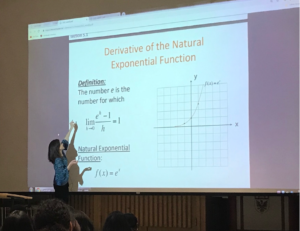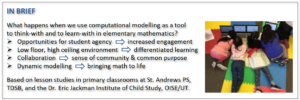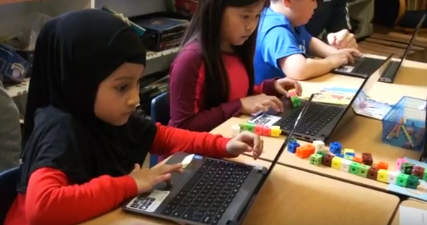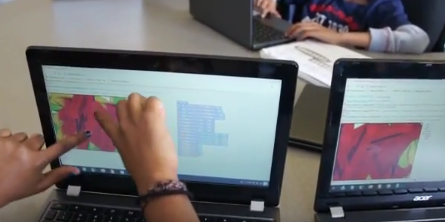NEWS
Coding and Math in Social Studies
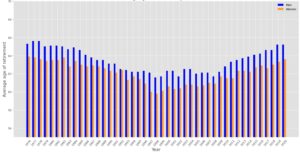 Jeff Cummings, St. James CHS, in the Wellington CDSB, conducted a project last year, looking at how coding and math may be integrated with the secondary school Social Studies curriculum. The project involved accessing, representing and analyzing data from StasCan using Python.
Jeff Cummings, St. James CHS, in the Wellington CDSB, conducted a project last year, looking at how coding and math may be integrated with the secondary school Social Studies curriculum. The project involved accessing, representing and analyzing data from StasCan using Python.Coding in the Ontario Mathematics Curriculum, 1-8: Might it be transformational?
Read the March 2021 report at http://mkn-rcm.ca/wp-content/uploads/2021/03/CL-mkn-v3.pdf
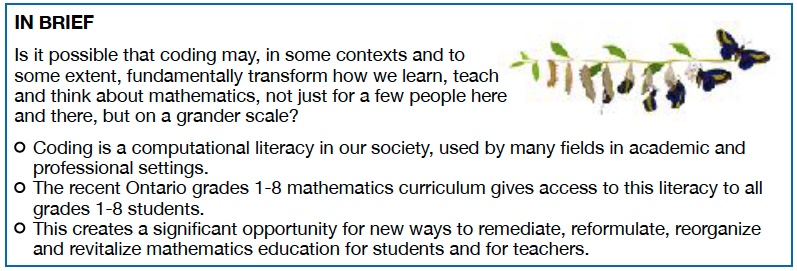 Might coding, in some ways and to some extent, fundamentally transform how we learn, teach and think about mathematics in grades 1-8 education?
Might coding, in some ways and to some extent, fundamentally transform how we learn, teach and think about mathematics in grades 1-8 education?
To answer this question we turn to diSessa (2000, 2018), to view coding through a literacy lens, and map the Ontario situation to diSessa’s literacy principles.
The “evidence” we use comes from 3 sources: Ontario curriculum documents, teaching resources developed by team members, and data from mathematics + coding classroom research conducted by team members in Ontario and in Brazil.
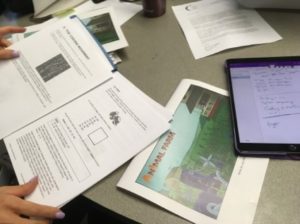 Cast a Wide Net at St Andrews PS, TDSB: AI, robotics, coding, math, social studies (December 2018). Sometimes, in order to learn about specific things, you have to approach it from many angles. Students are about to embark on a journey that will take in literature, communication, mathematics, coding, engineering, making, and most importantly – thinking. Read the report by Iain Brodie to learn what the grade sevens at St. Andrews Public School are about to do with artificial intelligence.
Cast a Wide Net at St Andrews PS, TDSB: AI, robotics, coding, math, social studies (December 2018). Sometimes, in order to learn about specific things, you have to approach it from many angles. Students are about to embark on a journey that will take in literature, communication, mathematics, coding, engineering, making, and most importantly – thinking. Read the report by Iain Brodie to learn what the grade sevens at St. Andrews Public School are about to do with artificial intelligence.
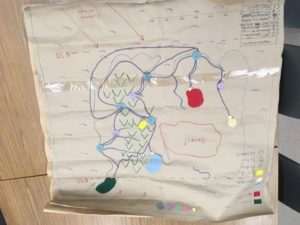 Modelling Civilization at St Andrews PS, TDSB: Coding, Making, Math (December 2018). Whether it is playing with and learning about infinity and limit, abstracting number patterns to find the nth term, or in our current case, modelling civilization mathematically with code, even our youngest students are capable of incredible feats of thinking and learning. Read the report by Iain Brodie to see how grade 3 students model their own civilizations in the classroom.
Modelling Civilization at St Andrews PS, TDSB: Coding, Making, Math (December 2018). Whether it is playing with and learning about infinity and limit, abstracting number patterns to find the nth term, or in our current case, modelling civilization mathematically with code, even our youngest students are capable of incredible feats of thinking and learning. Read the report by Iain Brodie to see how grade 3 students model their own civilizations in the classroom.
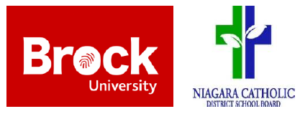
Brock U-NCDSB CT + Math Tasks (October 2018). With a focus on experiential learning, Brock University students worked collaboratively with Niagara Catholic District School Board teachers to develop engaging, coding-based activities for students that were explicitly or implicitly about mathematics. Explore their 4 CT-based math task summaries here.
Math, art, code (September 2018). This page includes web links for math + code + art, as well as annotated bibliographies on math + story/poem, math + dance/music, and math + arts theory.
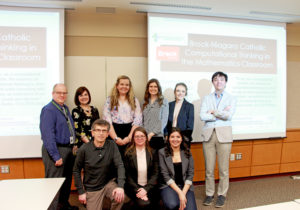 Brock U-Niagara Catholic DSB Computational Thinking Initiative (May 2018). With a focus on experiential learning, five Brock University students worked collaboratively with Niagara Catholic District School Board teachers to develop engaging, coding-based activities for students that were explicitly or implicitly about mathematics. Read the News Article from Brock University.
Brock U-Niagara Catholic DSB Computational Thinking Initiative (May 2018). With a focus on experiential learning, five Brock University students worked collaboratively with Niagara Catholic District School Board teachers to develop engaging, coding-based activities for students that were explicitly or implicitly about mathematics. Read the News Article from Brock University.
Computational Modelling in Elementary Mathematics Education – Making Sense of Coding in Elementary Classrooms (May 2018). Read the White Paper by CT CoP members, George Gadanidis (Western University) and Beverly Caswell (Robertson Program, OISE/UT).
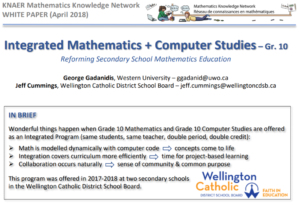 Integrated Mathematics + Computer Science – Grade 10: Reforming Secondary School Mathematics Education (April 2018). Read the White Paper by CT CoP members, George Gadanidis (Western University) and Jeff Cummings (Wellington Catholic DSB).
Integrated Mathematics + Computer Science – Grade 10: Reforming Secondary School Mathematics Education (April 2018). Read the White Paper by CT CoP members, George Gadanidis (Western University) and Jeff Cummings (Wellington Catholic DSB).
Coding for all: A story of purpose (December 2017). Read the newsletter from the Wellington Catholic DSB to learn about their innovative math + coding projects.
 Back to the Future – Hour of Math + Code (December 2017). Try out our classroom-tested activities and challenges here.
Back to the Future – Hour of Math + Code (December 2017). Try out our classroom-tested activities and challenges here.
Wellington CDSB Innovation Project in Math + Coding (November 2017). Check out the video overview!
CT CoP Overview (October 2017). See the slides by George Gadanidis (Western University) and Jeff Cummings (Wellington CDSB) for an overview of Year 1, and plans for Year 2!
2016-2017 Project Overview from Wellington CDSB (See the blog by Jeff Cummings to learn more!)
Literature review on Computational Thinking and Mathematics: see the current draft by Rosa Cendros (PhD candidate at Western University).
Repeating patterns + coding lesson study documentaries: Grades 1/2 and Grades 2/3.
Updated math + coding documentary on symmetry as a transformation: Grades 2/3. See the documentary.
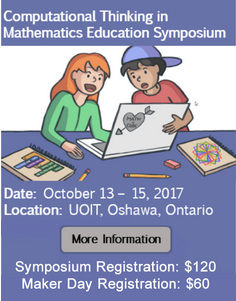 13-15 October 2017: Computational Thinking in Mathematics Education Symposium; a ctmath.ca event funded by the Fields Institute, hosted at UOIT, and organized by Immaculate Namukasa (Western) & Chantal Buteau (Brock); keynote speakers: Lyn English, Queensland University of Technology, and Uri Wilensky, Northwestern University.
13-15 October 2017: Computational Thinking in Mathematics Education Symposium; a ctmath.ca event funded by the Fields Institute, hosted at UOIT, and organized by Immaculate Namukasa (Western) & Chantal Buteau (Brock); keynote speakers: Lyn English, Queensland University of Technology, and Uri Wilensky, Northwestern University.
Wellington CDSB is developing a Math + Computer Science Cohort in Grade 10. See the article.
New issue of the Math + Code ‘Zine. See the new issue.
COMPUTATIONAL THINKING IN MATHEMATICS EDUCATION
The integration of computational thinking (CT) in mathematics teaching and learning can support the Ministry of Education’s mathematics goal of helping “students build a solid conceptual foundation in math” through dynamic modelling, by making abstract concepts “tangible” code objects, and by offering opportunities for students to develop robust understanding of mathematics concepts through hands-on investigations. CT also helps “provide students with a framework and tools for reasoning, justifying conclusions, and expressing ideas clearly” and “develop mathematical understanding, problem-solving skills, and related technological skills that they can apply in their daily lives, and eventually, in the workplace.” CT in its various forms – such as screen-based coding, unplugged procedures, and digital tangibles – is growing as a pedagogical interest within and outside of Ontario schools and there are pressures to include CT in curriculum. In January 2016, Prime Minister Justin Trudeau said, “We need to do a lot better job of getting young people to understand what coding is and how it’s important, how to program, how to problem solve, how to create the most elegant algorithm possible.” In the same month, B.C. announced that computer coding will be added to all grades of the K-12 curriculum. A similar announcement has been made by Nova Scotia. In Ontario, many schools are already providing CT experiences for students. How exactly should CT fit into the curriculum? This CoP will design and mobilize evidence-based and practice-based knowledge, integrating CT to support mathematics instruction. Some integration of CT in mathematics education (rather than simply teaching CT as a separate experience) will help address the issue of a crowded curriculum, and assist schools in meeting the RMS’s goal of a “minimum of 60 minutes each day of protected learning time for effective math instruction and assessment will be required for students in Grades 1 to 8”.
MEMBERS
Co-leads
Chantal Buteau (Brock University), Bev Casswell (Robertson Group, OISE/UT), George Gadanidis (Western University), Jeff Cummings (Wellington CDSB)
Members
Chantal Buteau (Brock University), Bev Caswell (Robertson Group, OISE/UT), Serge Demers (Laurentian University), Lisa Floyd (Western; TVDSB; Fair Chance Learning); Brigitte Goure (Providence), George Gadanidis (Western University), Marie-Hélène D’Amour (Providence); Jeff Cummings (Wellington CDSB), Judy Mendaglio (OAME), Matthew Oldridge (PDSB), Elizabeth Pearsall (Kingsville PS; SWAME/OAME representative at MKN), Belinda Russo (OECTA), Joe Russo (TCDSB), Ralph Shaw (Trent University), Bronna Silver (TDSB)
IMPLEMENTATION PLAN
Jeff Cummings & George Gadanidis are working in Wellington CDSB
- CT in elementary mathematics, 1 teacher per school, 22 schools
- knowledge to be shared with other teachers in the schools; and beyond the school district
- Grade 10 Math + Computer Science integration (cohorts) – 3 high schools
- Bryan McMillan will look into funds available to support a meeting on this theme with representatives from NCDSB and Providence
Bev Caswell, George Gadanidis & Bronna Silver are working in the primary division of 1 school in TDSB
- knowledge to be shared with other teachers in the school; to other schools in the district; and beyond the school district
- CT at the HS level
- project-based learning (students designing/coding math games)
Marie-Hélène D’Amour & Brigitte Goure are working in Providence
- district focus on technology (coding, making etc)
- shifting to mathematics + coding
- 18 schools, 2 teachers per school + 1 math lead teacher per school = approximately 54 teachers and 32 classrooms
- math development and technology integration (coding) through classroom support – co-teaching and co-planning
- technology leads will receive direct support from Marie-Hélène D’Amour and Brigitte Goure
- math leads will receive direct support from Marie-Hélène D’Amour and Brigitte Goure
Bev Caswell is working in Rainy River DSB, Seven Generations Education Institute, and Johnny Thierriault School in Aroland First Nation
- CT is one of the foci of this work
Joe Russo (21st Century Learning, TCDSB), is working on Mathematics, Coding and 21st Century Knowledge Construction.
Lisa Floyd, George Gadanidis & Immaculate Namukasa are working in teacher education at Western
- Designing and offering CT in Math Education courses for PJ, JI and IS teacher candidates.
Elizabeth Pearsall (Kingsville PS; SWAME/OAME representative at MKN) is working on bringing coding and robotics to Kingsville Public School
- A TLLP Project: Bringing Coding and Robotics to KPS – Everyone’s Learning a New Language
For more details, see the Computational Thinking TDSB and WCDSB Implementation Plan documents.
OUTCOMES & ACTIVITIES
Completed
- Classroom documentary on Symmetry + Code
Upcoming
- Bring representatives together from above groups to exchange ideas
- AFEMO & OAME publications and events – we can plan to have a “CT” day at OAME next year to showcase our work (as is happening this year with FNMI focus on Thursday, May 11th at OAME)
- L’AFEMO publishes it’s magazine 3 times a year. We hold virtual conferences twice a year. These are recorded and added to our web site. Our next conference will be in October of 2018. This would be a great opportunity to showcase the work done in 2017-2018.
- In the primary school site (with George, Bronna and Bev), let’s make sure that the French teacher joins our math sessions. I can also look into inviting the French teacher from Jackman ICS to join us. L’AFEMO can also help.
RELATED PROJECTS
- Computational Thinking in Mathematics Education. Researching the use of computational thinking in mathematics education, from pre-school to undergraduate mathematics, and in mathematics teacher education.
- Math + Code ‘Zine. We love math. We love coding. And we love the power of the two combined!
- ScratchMaths (UK). supporting computational and mathematical thinking through programming (Education Endowment Fund)
RESOURCES
- Computational Thinking in Mathematics Module (Western University)
- La pensée algorithmique (Académie royale de Belgique)

